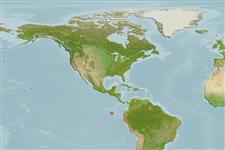>
Carangaria/misc (Various families in series Carangaria) >
Sphyraenidae (Barracudas)
Etymology: Sphyraena: Greek, sphyraina, -es = the name of a fish (Ref. 45335).
Environment: milieu / climate zone / depth range / distribution range
Ökologie
seewasser riff-verbunden; tiefenbereich 3 - 24 m (Ref. 5227). Tropical; 7°N -
Southeast Pacific: Peru, including the Cocos and the Galapagos islands.
Size / Gewicht / Alter
Maturity: Lm ? range ? - ? cm
Max length : 91.0 cm TL Männchen/unbestimmt; (Ref. 5590)
Found in temperate waters (Ref. 9345). Seen in groups of 3-20 from the surface to about 24 m (Ref. 5590). Feeds mainly on fish . Large individuals may slash prey into pieces before swallowing them. The front of each jaw is toothless and there is a series of large triangular teeth along each side of both jaws (Ref. 28023).
Life cycle and mating behavior
Geschlechtsreife | Fortpflanzung | Ablaichen | Eier | Fecundity | Larven
Merlen, G., 1988. A field guide to the fishes of Galapagos. Wilmot Books, London, England 60 p. (Ref. 5590)
IUCN Rote Liste Status (Ref. 130435)
Bedrohung für Menschen
Harmless
Nutzung durch Menschen
Mehr Information
NamenSynonymeMetabolismusRäuberÖkotoxikologieFortpflanzungGeschlechtsreifeAblaichenSpawning aggregationFecundityEierEientwicklung
Alter/GrößeWachstumLänge-GewichtLänge-LängeLängenhäufigkeitenMorphometrieMorphologieLarvenLarven Pop.Dyn.RekrutierungDichteBRUVS
ReferenzenAquakulturAquakultur ProfilZuchtlinienGenetikElectrophoresesVererbbarkeitKrankheitenVerarbeitungNutrientsMass conversion
PartnerBilderStamps, Coins Misc.LauteCiguateraGeschwindigkeitSchwimmstilKiemenoberflächeOtolithsGehirngrößeSehfähigkeit
Tools
Zusatzinformationen
Download XML
Internet Quellen
Estimates based on models
Preferred temperature (Ref.
123201): 20.2 - 27.8, mean 23.5 °C (based on 107 cells).
Phylogenetic diversity index (Ref.
82804): PD
50 = 0.5000 [Uniqueness, from 0.5 = low to 2.0 = high].
Bayesian length-weight: a=0.00724 (0.00339 - 0.01546), b=2.92 (2.74 - 3.10), in cm total length, based on LWR estimates for this Genus-body shape (Ref.
93245).
Trophic level (Ref.
69278): 4.5 ±0.80 se; based on food items.
Widerstandsfähigkeit (Ref.
120179): mittel, Verdopplung der Population dauert 1,4 - 4,4 Jahre. (Preliminary K or Fecundity.).
Fishing Vulnerability (Ref.
59153): High vulnerability (56 of 100).
Nutrients (Ref.
124155): Calcium = 16.2 [7.6, 42.6] mg/100g; Iron = 0.278 [0.133, 0.603] mg/100g; Protein = 20.3 [18.3, 22.0] %; Omega3 = 0.0769 [, ] g/100g; Selenium = 28.7 [12.5, 75.7] μg/100g; VitaminA = 47.1 [10.2, 232.1] μg/100g; Zinc = 0.461 [0.287, 0.789] mg/100g (wet weight);
